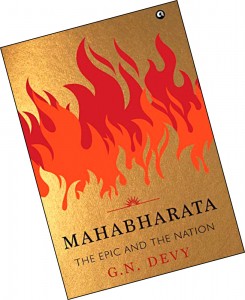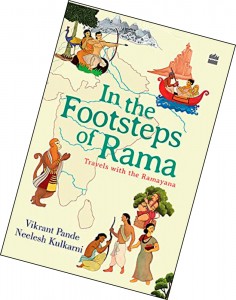Epic realities Revisiting two enduring narratives reinforces the belief that riches of the heart and mind result from a free and fair play of diversity.
When the centre cannot hold, as W B Yeats warned in ‘The Second Coming’, things fall apart, and ‘mere anarchy is loosed upon the world’. This is where we seem to be today. Where do we go from here is the tormenting question. While drowning in despondency, I chanced upon Mahabharata: The Epic and the Nation by G N Devy and my interest was piqued.
For one, Devy. After a teaching career, he headed a major linguistic survey with the help of 3,000 volunteers that led to ‘a comprehensive documentation of all living Indian languages in 50 volumes’ called the People’s Linguistic Survey of India. He works extensively with denotified and nomadic tribes, is the founder of the Bhasha Research and Publication Centre in Baroda, and the Adivasi Academy in Tejgadh, and writes in Marathi, Gujarati and English on subjects such as literary criticism, anthropology, education, linguistics and philosophy. He was among those who returned their Sahitya Akademi Award in protest against the threat to freedom of expression and growing intolerance.
For another, the timeless magic of the Mahabharata. As Devy observes, ‘It may not be quite off the mark to say that, among other cultural elements, the Mahabharata is one significant cultural production that brings Indians together. The diversity of language, land and life patterns in this country is so vast that no Indian can genuinely relate to all of it. Probably, it is through cultural practices and icons like the Mahabharata that we have a sense of being united.’
Devy argues that the epic has created a unique method of remembering the past, a method he says India has internalised, as ‘the way of preserving its national memory’. Then he goes on to make a significant statement: ‘The Mahabharata spirit is bound to agitate against any jingoistic and unitary sense of the subcontinent as a nation, for it is marked by an immense diversity of every kind. The Mahabharata unites us not in any imagined territorial national space; it brings us together in Time, symbolised by the never-stopping kala-chakra, the epic’s iconic symbol, which teaches us a great spirit of acceptance of all that is in complete humility.’
What about the Ramayana, then, the other timeless epic? That too has recently found expression in a unique book: no, not an interpretation but an engaging piece of travel writing. It all began with an innocuous question Vikrant Pande and Neelesh Kulkarni asked friends about where Chitrakoot was. Nobody knew, nor could they locate Kishkindha, although the names were familiar. So the two decided they would find out for themselves and started on a journey across India and Sri Lanka to all the places mentioned in the epic. This gave birth to In the Footsteps of Rama: Travels with the Ramayana. And before you pass judgement, it’s not a ‘religious’ work, it really is about travel, stories, and versions of stories, and the ‘willing suspension of disbelief’, to quote Coleridge.
Their journey begins and ends at Hanuman Garhi in Ayodhya, where Hanuman is said to have ‘settled down’. The mahant of this temple, Baba Gyan Das, asks: ‘Do you know who built this fort? It was a Muslim ruler. Not only did he build the fort, he also granted the temple freedom from all taxes and decreed that no one could litigate against it ever.’ According to him, the son of Abdul Mansoor Khan Safdarjang, the second Nawab of Oudh, was cured of leprosy by the power of Hanuman. In grateful thanks, Mansoor Khan built a fort to house the temple.
Each place they visit all the way down to Sri Lanka and back evokes several stories, often at variance with what they had read while researching the Ramayana prior to undertaking this journey. They meet interesting people, take in different landscapes and, yes, taste delicious food — or not! For instance, on the edge of Allahabad fort is where Sita is believed to have prayed before leaving for Chitrakoot; but before leaving Allahabad, our authors make sure to taste Bhagat Chaat Bhandar’s mouthwatering pakore ki chaat! From Delhi they take the Sampark Kranti Express to Chitrakoot where they were advised to stay because the forest had ‘plenty of animals to hunt, many trees that bear fruit, and where many ascetics have chosen to live.’
Pande and Kulkarni embark on a 450-foot descent through thick forest to Lonar lake in Maharashtra; the lake is in the middle of a crater which ‘is one of the only four impact craters in the world in basaltic rock and is still beautifully preserved. Maskelynite, a glass-like material that was thrown up by the impact, still shines through the sand at the edges of the lake.’ Locals believe the lake was ‘Shukracharya’s laboratory where he perfected the Sanjeevani drug that resurrected dead rakshasas.’
They come across a village en route to Nashik where, apparently, Sita was abandoned after aspersions were cast on her character. However, when the villagers ignored her pleas for help, she cursed them saying wheat would never grow in their soil. ‘The curse stayed for thousands of years, all the way till 1965, when the Green Revolution brought in a hybrid variety of wheat and other grains that could be grown here,’ a village elder tells the authors. ‘…grain stalks would simply crumble if we tried sowing wheat here…’
The world is full of Ramas and Ravanas, individuals of great merit, yet vulnerable to human frailties. But one thread runs through both epics, and that is the self-destructive nature of hate.
While they found some places difficult to locate, some seemed even to have been forgotten. But the majority were well remembered, both by the people and through folklore. At times, though, it seemed the stories were very much imagined, as in Mumbai, for instance. But, as a trustee of a temple in Walkeshwar tells them, ‘It is not about what happened here, but what people believe in.’ This remark makes the authors realise that ‘the truth is only what we want to believe. If people believe Rama came to Mumbai, then he sure did!’
Apparently, the popular stories about the Lakshman Rekha and Shabari tasting every berry she offered Rama has no literary or historical validity in any of the five versions of the epic — Tulsidas, Valmiki, Eknath, Kambar and Adhyathmak — the authors researched. A mismatch between distances mentioned in the epic and facts suggest that Lanka was possibly larger than the Sri Lanka of today. It is such an irony that a kingdom described as being rich and prosperous is now facing its biggest economic crisis.
‘We notice that most temples in Sri Lanka also house prominent Buddhist pilgrimage sites,’ the authors note. ‘The Murugan temple in Kataragama is more well-known for the Buddhist complex inside (it also houses a mosque, a church, a temple to a tribal deity, and a temple to Ganesha), apart from those dedicated to Murugan’s wives — Valli and Devayani.’ And at Nil Diya Pokuna, or blue water lake, they trudge through a pitch-dark tunnel in Istripuram to see the cave where Sita was supposedly hidden, but they don’t have the stomach to squeeze into the cave. ‘Many believe that Ravana still lives in these caves,’ their guide tells them as they beat a hasty retreat!
The world is full of Ramas and Ravanas, individuals of great merit, yet vulnerable to human frailties. But one thread runs through both epics, and that is the self-destructive nature of hate. Now, that’s a lesson for our time.
The columnist is a children’s writer and senior journalist


